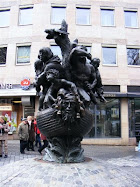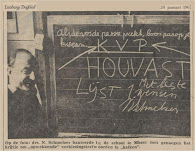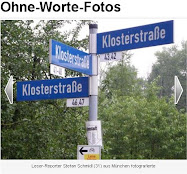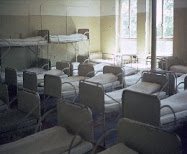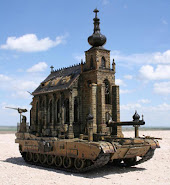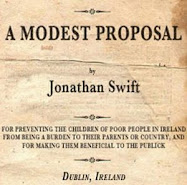The urgent calls of Nature to obey
These rules if thou wilt follow to the end
Thy life to greater length thou mayest extend
Salerno, Book of Health
vrijdag, juni 28, 2013
Una madre entrega a sus hijos al Ayuntamiento de Talavera al no poder cuidarlos
El Pais
Toledo. (EFE).- Dos bebés, varones, de once y veintidós meses, están en un centro de menores del Gobierno regional después de que su madre acudiera al Ayuntamiento de Talavera de la Reina (Toledo) para poner en manos de los servicios sociales el cuidado de sus dos hijos al no poder hacerse cargo de ellos por motivos económicos.
Según ha informado la concejala de Servicios Sociales, Igualdad y Relaciones Institucionales de Talavera, Ana Santamaría, la madre, que "no tiene ninguna vinculación" con esta localidad, acudió ayer al servicio de información del ayuntamiento talaverano y dejó a los niños con los funcionarios tras explicarles que no podía hacerse cargo de ellos. Según la edil, la madre pidió a los funcionarios que sus hijos estuvieran atendidos de la mejor forma posible.
Los padres de los menores están de paso por Talavera, ya que son "transeúntes por toda España". Los niños, que se encuentran ya en Toledo en un Centro de Menores del Gobierno Regional, están "sanos, bien cuidados y nutridos", ha manifestado la concejala.
Toledo. (EFE).- Dos bebés, varones, de once y veintidós meses, están en un centro de menores del Gobierno regional después de que su madre acudiera al Ayuntamiento de Talavera de la Reina (Toledo) para poner en manos de los servicios sociales el cuidado de sus dos hijos al no poder hacerse cargo de ellos por motivos económicos.
Según ha informado la concejala de Servicios Sociales, Igualdad y Relaciones Institucionales de Talavera, Ana Santamaría, la madre, que "no tiene ninguna vinculación" con esta localidad, acudió ayer al servicio de información del ayuntamiento talaverano y dejó a los niños con los funcionarios tras explicarles que no podía hacerse cargo de ellos. Según la edil, la madre pidió a los funcionarios que sus hijos estuvieran atendidos de la mejor forma posible.
Los padres de los menores están de paso por Talavera, ya que son "transeúntes por toda España". Los niños, que se encuentran ya en Toledo en un Centro de Menores del Gobierno Regional, están "sanos, bien cuidados y nutridos", ha manifestado la concejala.
Labels:
Europa,
Spanje,
verhalen van 1001 nacht.
woensdag, juni 26, 2013
€25m redress fund for former Magdalene residents
No proposal for reconciliation forum
Irish Times
26-6-2013
The Government has made a provision of at least €25 million to compensate former residents of Magdalene Laundries. It is also understood there is no proposal for a reconciliation forum involving the four religious congregations who ran the 10 laundries concerned and the women who had been resident in them, as was mooted recently
Details of the fund that will be available to an estimated 700 women, many of them elderly, will be disclosed by Minister for Justice Alan Shatter this afternoon after he has briefed groups representing the women.
Sources with knowledge of the process have said that payments will range from €10,000 to about €100,000, related to length of stay of women in the laundries. It is also believed that ongoing health and other such supports for the women will be provided by the State.
A report by former High Court judge Mr Justice John Quirke examining the various forms of redress and support to be made available to the women will also be published today. No details have emerged as to the nature of the payments, whether they will be once-off lump sums or paid in stages, which was the initial preferred option of Government.
Mr Justice Quirke conducted a three month
review and submitted his report to Mr Shatter at the end of May. His
remit was to look into the feasibility of payments and other supports,
including medical cards, psychological and counselling services.
dinsdag, juni 25, 2013
en wie het kindje krijgt mag het houden Operación Bebé
21-6-2013
On the day staff at the Xeral Calde hospital in Lugo, in Galicia, brought the papers for Paula to sign away her newborn baby, Juan, for adoption, she was heavily sedated, having been given repeated doses of valium: one at 9am, another at 11am, and the third shortly before lunch. "She was like a zombie. She didn't know what she was doing; she would have signed anything," says a hospital orderly who was present, and who has since given evidence as a witness in the judicial investigation opened one year after the birth of Juan into more than a dozen breaches of adoption procedures at the hospital.
The orderly says that he had been told that Paula was a "dangerous" schizophrenic and that he should keep her door closed at all times and not to let her out of his sight. "It was like a kidnapping," he told the judge. "If anybody talked, the deal was off."
 |
| bron EL PAIS |
The authorities in Lugo are investigating other stories similar to Paula's, dating back a decade. In 2006, a young woman who had handed her child over a month earlier, jumped out of an eighth-floor window. She survived, but is now completely paralyzed. In 2003, another woman signed her child away after she was threatened by a Russian suspected of belonging to an organized crime gang. The man had allegedly told her that if she did not hand over the baby, he would kill her other child. Another says that social workers took away her first baby, and then her second. She was allegedly told that she was "too poor" to look after them.
After three valiums, she would have signed anything; she was a zombie"
The case has barely made the headlines in Galicia: the media have been kept busy over the last two years by continued revelations about political corruption at the highest levels.
Operation Baby, as some have dubbed the case, has echoes of the stories that have surfaced in Spain about a network of doctors and religious orders who provided wealthy families with babies during the Franco period and into the 1980s.
"We've read in the papers about babies being stolen during the Franco years, but it's been going on here until now," says the lawyer of a young Algerian woman whose baby was taken away from her shortly after birth at the hospital in Burela, Lugo province, in February 2011. She has brought legal proceedings to halt the adoption process, currently underway in neighboring Pontevedra. The young woman, who came to Spain to work as a domestic employee, says that she barely spoke Spanish at the time, and that she believed the adoption papers she signed were paperwork authorizing her release from hospital.
Police finally began looking into irregularities in adoption procedures in Galicia after four lawyers filed complaints against the regional government, which runs the health service. The exact number of babies allegedly taken from their mothers on the grounds that they were not able to provide their newborn with a proper home is still not clear: sources at Lugo's provincial court say "almost 20 families" are involved, while other sources say the number of babies alleged to have been stolen is around a dozen. The most recent documented case, seen by EL PAÍS, dates from May 2011.
Lawyers for the families involved accuse social workers from Galicia's Minors Department of taking babies away from their mothers "with a view to having them adopted" on "arbitrary" criteria based on subjective reports they either wrote themselves or had prepared by Franciscan nuns from the Madre Encarnación Home.
Good Shepherd Sisters denying history
The recent claims, by lawyer and lobbyist Bryan Keon-Cohen, that the Catholic Church is a law unto itself in its resistance of governmental responses to child abuse, could be applied to Good Shepherd Australia New Zealand.On the 22nd of this month, Good Shepherd, an organisation established by the Good Shepherd Sisters has scheduled a Festival at Abbotsford Convent in Melbourne in order to celebrate 150 years since the Good Shepherd Sisters arrived in Australia. The problem is that the summary, by Trish Carroll, Good Shepherd Mission Leader, of the history of the organisation, conveniently excludes the work of the Sisters in the twentieth century. So allow me to fill in the resounding gap.
There are no precise figures for the number of girls who slaved in the eight Magdalene laundries, run by the Good Shepherd Sisters, in twentieth century Australia because Good Shepherd has not released their records. We do know, as a result of the Federal Senate reportForgotten Australians (2004) that the Good Shepherd laundries in Australia acted as prisons for the girls who were forced to labour in workhouses laundering linen for local hospitals or commercial premises. The report alsodescribed the conditions as characterised by inedible food, unhygienic living conditions and little or no education. In 2008, in Federal Parliament, Senator Andrew Murray likened the Convent of the Good Shepherd 'The Pines', Adelaide to a prisoner-of-war camp.
Post-war Australia was categorised by a new era of nation building led by the conservative Robert Menzies as Prime Minister. There was a perceived need for strict discipline for juveniles. Children could be placed in juvenile detention centres despite not having committed a criminal offence. Further, during this period there was a concern that 'sexually depraved girls' could be a cause of delinquency and therefore needed to be separated from the mainstream. As a result of these attitudes, many vulnerable children were criminalised.
Rachael Romero, at the age of 14 in 1967, was incarcerated in 'The Pines' for running away from her violent father who had sexually abused her. Rachael could not speak about it publicly for forty years because the Good Shepherd Sisters had branded her as 'fallen' and so Rachael had felt besmirched as a result of the abuse that she had endured. Wendy Sutton was admitted to 'The Pines' at the age of 13 having suffered physical abuse at the hands of her stepfather and having been sexually molested by a friend of the family.
Janice Konstantinidis was sent, by whom she describes as her 'sadistic alcoholic father' at the age of 12 to work in the laundry at Mount Saint Canice, run by the Good Shepherd Sisters in Tasmania. Janice remembers the girl who broke her back in an escape attempt by jumping through a window. The girls were told later that after being discharged from hospital that she was sent to Lachlan Park Hospital, a secure mental asylum.
Maureen Cuskelly was sent to Abbotsford Convent at the age of three because her mother was suffering from a mental illness. Later at the age of 13, in 1968, she was sent to work in the laundry at St Aidan's Bendigo, run by the Good Shepherd Sisters. When she left, at the age of 17, her hands were damaged from years of repetitive sheet folding, in the afternoons, and her being forced to clean floors with an industrial polisher every morning.
The Good Shepherd Festival at Abbotsford this month also includes a 'ReunionAfternoon Tea for all former residents of Good Shepherd institutions'.
I asked Maureen if she would be going, "I don't know about that. There is not one plaque at Abbotsford about us. It's all about them. They make me so mad. There has been no apology. No acknowledgement".
I went to a reunion before and they say 'The nuns did their best at the time'. But they didn't do their best. They were cruel. We were always hungry and cold. Girls were beaten or locked on their own in dark cells. But the worse thing they did was not let me see my brother and sister in the other section of the Convent. I got punished for waving at them".
The Senate Inquiry into Forgotten Australians (2004) revealed that the abuse of children continued throughout institutions because a nation espoused an uncritical admiration of the work of charities and churches. Who was watching those charged with the care of Australia's vulnerable children? We can take account now. Many Forgotten Australianshave fought emotional adversity and physical scars or injuries to participate in a society that abandoned them as children. Our history needs to acknowledge the causal factors that produced such adversity so as to deflect the shame and stigma from survivors. Good Shepherd Australia New Zealand, whose slogan is "Justice, Compassion, Reconciliation, Respect, Dignity" can assist this reparation by focusing less on their public relations campaign, more on writing an authentic record and through the initiation of a genuine reconciliation process with former child slaves of their twentieth century laundries.
Maureen reminds us the significance of the current Good Shepherd's edited history, "They're burying what they did. They're burying our history. They're burying the truth".
zondag, juni 23, 2013
Savages and the forks
 What the commission doesn't have is money to build a promised national residential schools research archive.
What the commission doesn't have is money to build a promised national residential schools research archive. In a long ceremony packed with politicians and aboriginal dignitaries Friday, the commission and the University of Manitoba signed an agreement to set up the national research centre, which will see the university take on the massive job of reviewing, organizing and digitizing millions of residential school records. That includes government and church documents, 6,000 oral histories taken from residential school survivors and their families, artifacts and photos.
In a long ceremony packed with politicians and aboriginal dignitaries Friday, the commission and the University of Manitoba signed an agreement to set up the national research centre, which will see the university take on the massive job of reviewing, organizing and digitizing millions of residential school records. That includes government and church documents, 6,000 oral histories taken from residential school survivors and their families, artifacts and photos.Most of the records are still held by Library and Archives Canada. Only now, after a court battle, are they being prepared to be given to the commission and the university.
So far, there is no secure source of funding for a startup research centre, expected to be housed in existing space on campus. The U of M has committed space and funding for three positions, but additional funding is needed. Organizers hope it can come from the parties to the residential schools court settlement, including the federal government and Canada's largest churches. They hope funding can be secured by the time the commission winds up in a year.
There is also no long-term funding for a stand-alone residential schools research centre, the ultimate goal. University staff is exploring the possibility of building on the site of the former Southwood golf course, which the university owns and plans to redevelop. A public fundraising campaign may be launched as part of the university's capital building plans, and it could be five to 10 years before the centre opens.
The creation of a research centre and the preservation of the residential schools archive was originally meant to be funded by the commission's $63-million budget.
But commission chairman Murray Sinclair has said funding is not adequate to meet the commission's five-year mandate, let alone process records and open a research centre.
 |
| KLIK |
"What we have begun to no longer deny, we will never forget," commissioner Marie Wilson told the gathering Friday. "Our country will never be able to say this never happened."
The records will help researchers delve deeper into the conditions at specific schools, illuminate how churches and government dealt with allegations of abuse and help count of how many children died in residential schools and where they are buried. So far, the TRC more than 4,000 children have been counted.
"Even for those who never made it home from school, the evidence is there, that they might be remembered," said elder and survivor Garry Robson, whose late brother also went to a residential school and led a troubled life. "I saw him run all his life, trying to get away from the memory, and he was never able to shake it."

bring rubber boots
the Forks might be muddy despite the sun
Labels:
canada,
gebruik grenzen,
gereedschapskist,
ITRC,
vic.org
zaterdag, juni 22, 2013
C & A tje, Campus at sea; pestblognootje
“Maar dominee voegde eraan toe dat al die mensen die zo graag uniek willen zijn, zich wel allemaal identiek kleden.” Of de dominee daarmee had bedoeld dat de mensen eigen…
vrijdag, juni 21, 2013
Hof van Cassatie van België; KIB 6, nu met Roger Vangheluwe - Bye, Bye Aartsbisdom/Danneels? Weinig is wat het lijkt.
Bericht 20/06/2013 –
Weinig is wat het lijkt. Daarom een poging om het Arrest van het Hof van Cassatie van 18/06/2013 over de verdwijning van PV's te lezen als niet- jurist. De memories van toelichting worden in het arrest als bijlagen beschouwd.
1. Het arrest van het Hof van Cassatie m.b.t. de verdwijningen pv's
1.1. bijgevoegd via (nog niet bijgewerkte site ) Operatiekelk.be
Documenten :
Arrest Hof van Cassatie 18/06/2013 met 2 bijlagen:
- Memorie Jan Hertogen
- Vordering Openbaar Ministerie
1.2. Oeps, Vangheluwe vergeten uit te nodigen L... P.... en J.... D....* van het federaal parket hadden vergeten Roger Vangheluwe uit te nodigen op het KIB over de verdwijingen op 05/02/2013, overeenkomstig artikel 235bis, hetzelfde artikel op basis waarvan Van Steenbrugge en ikzelf gelijk kregen voor Cassatie om het vonnis van het eerste KIB van augustus 2010 over operatie kelk te vernietigen. Niets nieuws onder de zon, alleen een voorkoombare nalatigheid van het federaal parket.
1.3. Bye, Bye Aartsbisdom en Danneels?
Zullen het Aartsbisdom en Danneels nog uitgenodigd worden bij de volgende behandeling van de verdwijningen pv's voor een nieuw samengesteld KIB? Een goed deel van het rekwisitoor van het Openbaar Ministerie ging erover om te bewijzen dat het Cassatieberoep vanwege Aartsbisdom en Danneels niet ontvankelijk waren én dat hun aanwezigheid op het KIB dat de zaak behandeld had onterecht was. Aartsbisdom en Danneels zijn nog nergens in beschuldiging gesteld en kunnen ook niet er mee gelijk gesteld worden; zo zegt het Openbaar Ministerie, er is daarbij geen enkele burgerlijke partijstelling of klacht tegen hen ingesteld. Zij zijn dus in geen enkel opzicht betrokken partij zo concludeert het Openbaar Ministerie. In een aparte nota heeft advocaat Keuleneer zich uit die houdgreep proberen te bevrijden.
Wij begrijpen er uit dat, samen met de volledige nietigheid van de inbeslagnames bij Aartsbisdom en Danneels de juridische vertegenwoordigers van de slachtoffers nagelaten hebben om een rechtstreeks klacht in te dienen tegen de kerk, Aartsbisdom en Danneels. Komen, met het eventueel weren van Aartsbisdom en Danneels uit het strafonderzoek, in feite de burgerlijke procedure in Gent ook zonder voorwerp?
In het arrest van het Hof van Cassatie worden Aartsbisdom en Danneels wel vermeld als 'voorheen verzoekers tot opheffing onderzoekshandelingen'. Zien of zij nog uitgenodigd worden op het volgende KIB of is het Bye, Bye voor hen en de kerk.
1.4. De memorie van eiser III (met ondermeer kort verslag van vorige KIB-verdwijningen)
"Eiser III (Jan Hertogen) voert in een memorie die aan dit arrest is gehecht 4 grieven aan.'' zo staat in het arrest, dat vervolgt met "de hierna uit te spreken vernietiging van de beslissing op het cassatieberoep van de eiser II brengt ook de vernietiging van de beslissing in zoverre zij betrekking heeft op de eisers I en III. De middelen en grieven kunnen niet tot cassatie zonder verwijzing leiden. Zij behoeven geen antwoord."
Omgekeerd, zo begrijpen wij, leiden de middelen en grieven van eisers I en II wel tot cassatie met verwijzing en zal het nieuwe en anders samengesteld KIB op hun middelen en grieven; en deze van alle andere partijen, moeten antwoorden gezien het een volledige cassatie betreft. Enige info over cassatie zonder verwijzing.
In de conclusies van het Openbaar Ministerie werd kort ingegaan op de ontvankelijkheid en de grieven van eiser III.
"Maar ook hier blijft de vraag of de eiser III toch niet enig belang kan hebben bij zijn cassatieberoep" zo stelt het OM, "nu het bestreden arrest oordeelt dat de procedure door geen enkel gebrek is aangetast en de eiser II! aanvoert dat er geen zekerheid is omtrent de volledigheid van het strafdossier en de kamer van inbeschuldigingstelling dit niet kon nagaan aan de hand van de door haar gebruikte onderzoeksmethode, die niet voldoende betrouwbaar was. De eiser III heeft dus kritiek op het gebrek aan interne coherentie van de motivering die uiteindelijk heeft geleid tot de conclusie dat de procedure door geen enkel gebrek is aangetast. Om die redenen meen ik dat de eiser III wel degelijk een belang heeft bij zijn cassatieberoep en dat dit cassatieberoep derhalve ontvankelijk is."
De interne coherentie en de betrouwbaarheid van de onderzoeksmethode wordt dus door het OM aan de orde gesteld, en daar was het ons om te doen, dwz een steekproef houden in 1 arrondissement (Brussel) en nalaten om de volledigheid van het dossier schuldig verzuim na te gaan voor de 26 andere arrondissementen laat geen enkele conclusie toe voor het geheel.
Men kan zich afvragen waarom de andere slachtoffervertegenwoordigingen zich daar geen zorgen om maken. Zien of zij dit in het nieuwe KIB dit nu wel aan de orde zullen stellen.
1. Het arrest van het Hof van Cassatie m.b.t. de verdwijningen pv's
1.1. bijgevoegd via (nog niet bijgewerkte site ) Operatiekelk.be
Documenten :
Arrest Hof van Cassatie 18/06/2013 met 2 bijlagen:
- Memorie Jan Hertogen
- Vordering Openbaar Ministerie
1.2. Oeps, Vangheluwe vergeten uit te nodigen L... P.... en J.... D....* van het federaal parket hadden vergeten Roger Vangheluwe uit te nodigen op het KIB over de verdwijingen op 05/02/2013, overeenkomstig artikel 235bis, hetzelfde artikel op basis waarvan Van Steenbrugge en ikzelf gelijk kregen voor Cassatie om het vonnis van het eerste KIB van augustus 2010 over operatie kelk te vernietigen. Niets nieuws onder de zon, alleen een voorkoombare nalatigheid van het federaal parket.
1.3. Bye, Bye Aartsbisdom en Danneels?
Zullen het Aartsbisdom en Danneels nog uitgenodigd worden bij de volgende behandeling van de verdwijningen pv's voor een nieuw samengesteld KIB? Een goed deel van het rekwisitoor van het Openbaar Ministerie ging erover om te bewijzen dat het Cassatieberoep vanwege Aartsbisdom en Danneels niet ontvankelijk waren én dat hun aanwezigheid op het KIB dat de zaak behandeld had onterecht was. Aartsbisdom en Danneels zijn nog nergens in beschuldiging gesteld en kunnen ook niet er mee gelijk gesteld worden; zo zegt het Openbaar Ministerie, er is daarbij geen enkele burgerlijke partijstelling of klacht tegen hen ingesteld. Zij zijn dus in geen enkel opzicht betrokken partij zo concludeert het Openbaar Ministerie. In een aparte nota heeft advocaat Keuleneer zich uit die houdgreep proberen te bevrijden.
Wij begrijpen er uit dat, samen met de volledige nietigheid van de inbeslagnames bij Aartsbisdom en Danneels de juridische vertegenwoordigers van de slachtoffers nagelaten hebben om een rechtstreeks klacht in te dienen tegen de kerk, Aartsbisdom en Danneels. Komen, met het eventueel weren van Aartsbisdom en Danneels uit het strafonderzoek, in feite de burgerlijke procedure in Gent ook zonder voorwerp?
In het arrest van het Hof van Cassatie worden Aartsbisdom en Danneels wel vermeld als 'voorheen verzoekers tot opheffing onderzoekshandelingen'. Zien of zij nog uitgenodigd worden op het volgende KIB of is het Bye, Bye voor hen en de kerk.
1.4. De memorie van eiser III (met ondermeer kort verslag van vorige KIB-verdwijningen)
"Eiser III (Jan Hertogen) voert in een memorie die aan dit arrest is gehecht 4 grieven aan.'' zo staat in het arrest, dat vervolgt met "de hierna uit te spreken vernietiging van de beslissing op het cassatieberoep van de eiser II brengt ook de vernietiging van de beslissing in zoverre zij betrekking heeft op de eisers I en III. De middelen en grieven kunnen niet tot cassatie zonder verwijzing leiden. Zij behoeven geen antwoord."
Omgekeerd, zo begrijpen wij, leiden de middelen en grieven van eisers I en II wel tot cassatie met verwijzing en zal het nieuwe en anders samengesteld KIB op hun middelen en grieven; en deze van alle andere partijen, moeten antwoorden gezien het een volledige cassatie betreft. Enige info over cassatie zonder verwijzing.
In de conclusies van het Openbaar Ministerie werd kort ingegaan op de ontvankelijkheid en de grieven van eiser III.
"Maar ook hier blijft de vraag of de eiser III toch niet enig belang kan hebben bij zijn cassatieberoep" zo stelt het OM, "nu het bestreden arrest oordeelt dat de procedure door geen enkel gebrek is aangetast en de eiser II! aanvoert dat er geen zekerheid is omtrent de volledigheid van het strafdossier en de kamer van inbeschuldigingstelling dit niet kon nagaan aan de hand van de door haar gebruikte onderzoeksmethode, die niet voldoende betrouwbaar was. De eiser III heeft dus kritiek op het gebrek aan interne coherentie van de motivering die uiteindelijk heeft geleid tot de conclusie dat de procedure door geen enkel gebrek is aangetast. Om die redenen meen ik dat de eiser III wel degelijk een belang heeft bij zijn cassatieberoep en dat dit cassatieberoep derhalve ontvankelijk is."
De interne coherentie en de betrouwbaarheid van de onderzoeksmethode wordt dus door het OM aan de orde gesteld, en daar was het ons om te doen, dwz een steekproef houden in 1 arrondissement (Brussel) en nalaten om de volledigheid van het dossier schuldig verzuim na te gaan voor de 26 andere arrondissementen laat geen enkele conclusie toe voor het geheel.
Men kan zich afvragen waarom de andere slachtoffervertegenwoordigingen zich daar geen zorgen om maken. Zien of zij dit in het nieuwe KIB dit nu wel aan de orde zullen stellen.
2. Het nieuw samengesteld KIB over de verdwijningen pv's:
een Shakespeariaans drama?
Wie zijn genodigd als deelnemers aan de 2de act:
1. Het anders samengesteld Hof bestaande uit drie rechters
2. L. P.../J.. D....* van het federaal parket als Openbaar Ministerie
3. Het Aartsbisdom en Danneels en hun advocaat Keuleneer indien nog uitgenodigd
4. Roger Vangheluwe en z'n advocaat Van Cauter
5. Van Steenbrugge, Mussche, Mees namens 69 Burgerlijke partijen slachtoffers
6. Andere individuele slachtoffers Burgerlijke Partijen waaronder mezelf.
7. Wim De Troy, oud- onderzoeksrechter
8. P... C...*, oud-griffier
9. B... B....*, in het eerste KIB opgeroepen door C* die zonder hem geen verklaring zal afleggen
10. Colette Callewaert, huidige onderzoeksrechter 'operatie kelk'
11. Huidig griffier die een aantal maanden de gang van zaken onder De Troy heeft kunnen observeren.
Maar allicht zal ook dit nieuwe KIB geen journalistiek activiteit losweken om bv eens na te gaan hoe een en ander aan elkaar te rijmen is. Wie neemt het deksel eens weg van de stinkende pot die operatie kerk van in het begin geweest is. Of houdt men het lot van Dirk Tieleman in gedachte die hiertoe een poging gedaan heeft en vervolgens door iedereen genegeerd en verzwegen werd.
3. Het belangrijkste is gebeurd voor de slachtoffers
Intussen, en dat mag wél een troost zijn, heeft de kerk haar boontjes gedopt in de Arbitragecommissie, een soort commissie Adriaenssens light die voor heel wat slachtoffers erkenning en heling gebracht heeft. Evenzo voor de 10 contactpunten van de kerk die ook in de toekomst een opvang en perspectief bieden voor slachtoffers.
4. Het volledige deficit van het gerecht
De absoluut negatieve kant van dit verhaal is dat de meldingen van slachtoffers bij Adriaenssens, de aanvragen bij de arbitragecommissie en de meldingen bij de 10 contactpunten volledig buiten beeld van het gerecht blijven, of er zouden opnieuw inbeslagnames moeten zijn bij de arbitragecommissies en de contactpunten.
Op een aantal (nieuwe) meldingen na van slachtoffers bij het gerecht na de nietigverklaring van de in beslag genomen dossiers, blijft de overgrote meerderheid van de gevallen van seksueel misbruik in een pastorale relatie buiten beeld van het gerecht. Bij de commissie Adriaenssens was er nog toegang van het gerecht tot alle dossiers, nu kan het gerecht nergens meer aan, niet aan de 627 van de arbitragecommissie noch aan de 250 van de kerkelijke contactpunten.
Enkel de kerk is nog in de mogelijkheid om deze af te punten en nog een daderpopulatie op te maken alsmede na te gaan hoeveel van de Adriaenssens-dossiers terug gekomen zijn in de arbitragecommissie en de contactpunten. Maar daar is, en niet door de kerk, voor eeuwig het zwijgen over opgelegd.
In feite is deze vaststelling niet alleen het deficit van het gerecht maar ook van wie het (gerechtelijk) belang van de slachtoffers heeft menen te verdedigen in de illusie 'eindelijk recht te doen zegevieren'.
5. En nog dit
Op 07/06/2013 ben ik 'dringend, uitgebreid en ten gronde' verhoord over het vrijgeven van elementen uit het pv van Calewaert mbt de verdwijningen van pv's. Ik heb verklaard dat ik art. 460ter gerespecteerd heb en conform aan art. 61ter, §4 gehandeld. Daarbij vond ik het verhoor tergend en roekeloos. Het verhoor vond plaats in opdracht van Procureur des Konings Jos - dat is dan jammer voor de slachtoffers - C...* van Brussel.
Jan Hertogen.
* Namen hier als weinig opportuun voor buitenlanders, 't is zonder buiza potentieel al schandalig genoeg, weggehaald.
 |
| Adriaenssens: Naast meldingen van 6 pogingen tot pleegden minstens 13 slachtoffers zelfdoding KLIK |
Tantetje down under
MEDIA RELEASE:
CATHOLICCARE DOESN’T CARE!
CATHOLICCARE DOESN’T CARE!
Once again Cardinal Pell’s statements of care and concern have shown to be absolute and total lies as a 90 year old woman struggles to get one sentence about her childhood in a NSW orphanage.
Recently, CLAN was contacted by a 90 year old woman from Western Australia, as media about the Royal Commission had triggered for her issues of abuse in two Catholic orphanages in NSW.
CLAN applied on her behalf for her records at the CatholicCare Bankstown office last Friday and had provided the organisation with her birth and marriage certificates as well as signed documents stating that she gave permission for CLAN to receive her records on her behalf.
These records are vital for Care Leavers in order to receive assistance from services that they are entitled to and to provide information for their submission to the Royal Commission, and to learn about their family history.
CLAN was informed that those records would be delivered this Monday. We stressed that she was 90 years old to the caseworker at CatholicCare. We were telephoned on Tuesday to be informed that we would not receive the information – which is only one line in a book –entry and exit dates, due to the fact that the birth and marriage certificates were not certified copies.
CLAN is forced to ask - Is this how the Catholic Church deals with people who were abused?
CatholicCare is the only past provider of orphanages and children’s Homes in NSW that has put obstructions and brick walls in the paths of people who were abused as children. Their statements of care and compassion have proven fruitless.
CLAN Executive Officer, Leonie Sheedy stated “CatholicCare - what a strange name to call themselves? What care has been given to this 90 year old woman? CatholicCare is retraumatising NSW Care Leavers with this archaic policy.”
CLAN hopes that the Royal Commission into institutional responses to child sexual abuse will retrieve all records from this past provider agency.
Former residents to boycott nuns' reunion
The Age
21-6-2013
Carolyn Webb
Members of a support group for people who grew up in care say they will boycott a reunion organised by the Good Shepherd nuns as part of celebrations for the order's 150th anniversary in Australia. Care Leavers Australia Network chief executive Leonie Sheedy said the
nuns' event was inappropriate ''when they haven't acknowledged, or
publicly apologised for, the damage that's been done to children in
their care''.
Care Leavers Australia Network chief executive Leonie Sheedy said the
nuns' event was inappropriate ''when they haven't acknowledged, or
publicly apologised for, the damage that's been done to children in
their care''.With the Royal Commission into Institutional Responses to Child Sexual Abuse under way and the state inquiry into how the churches handled clergy sexual abuse to report later this year, abused former residents of Good Shepherd institutions said there was nothing to celebrate.
The nuns, on their webpage, say the June 21 and 22 celebrations at the Abbotsford Convent will include tours and an exhibition.
Advertisement
Ms Sheedy said many CLAN members would boycott a reunion afternoon tea ''for all former residents of Good Shepherd institutions'' at the convent on Friday.
She said they felt their lives had been ruined as girls and young women by being forced to do harsh, unpaid labour - for example, in industrial laundries - and by physical, sexual and mental abuse.
Ms Sheedy believes the royal commission may have something to do with why the nuns are holding the reunion. ''It's to show that they're engaging with the women.'' She said survivors of Good Shepherd institutions had received no compensation, except for a handful who were offered up to $5000 each.
Stena Keys, of Portarlington, who laboured at Abbotsford aged 13 in the late 1960s, sees ''nothing to celebrate'' this weekend.
''I was sexually abused by two of the other residents there, the other girls, and the nuns verbally abused me,'' she said.
She said the nuns shouldn't hold a reunion. ''Definitely not as a celebration. Maybe more as an apology.
''I worked in the laundry. I did the slave child labour for them. I worked on the presses. I'm definitely paying for it now … physically I'm just no good. I'm 56 and I can barely get around.''
Heather Templeman, of Hastings, said her legs were burnt by hot pipes and her knees were ruined when she was forced to work for three years in the convent laundry from 1958, aged 16.
''The ironing was done for the Windsor Hotel, the Savoy, the Plaza, we earnt a lot of money for them, but we didn't get paid for it.''
She said of the reunion: ''What's it celebrating? I'm not sure why they're doing it, to make them look good or something? But it doesn't help, the damage is done.
''My shoulders are bad, I'm waiting for a knee replacement and the other knee is going.''
She said a staff member - not a nun - once punched her for hiding in a cupboard as part of an escape attempt.
In a statement, Good Shepherd province leader Sister Anne Manning said counsellors would be at the reunion. Not all former residents are happy about the event, but 104 were coming ''and are looking forward to it''.
The reunion had ''absolutely nothing'' to do with the royal commission. ''We believe it is appropriate to include former residents as part of our 150th celebrations. They are part of our history.''
“The laundries were commercial enterprises that operated on a low cost basis to provide services to the public and indeed the State, the State benefitted from services that were based on forced or compulsory labour in the past.”
The Irish Times
The Irish Human Rights Commission (IHRC) has repeated its 2010 call for a statutory inquiry into the Magdalene laundries.
It
also said comprehensive compensation was needed for survivors of
Magdalene laundries including unpaid wages and pensions and rehab for
forced labour, a watchdog has claimed.
In its Follow-up Report on State Involvement with Magdalen Laundries,
published today (Tuesday), the IHRC found “the State failed in its
obligations to protect the human rights of girls and women in the
laundries.”
It called for “a comprehensive redress scheme that
provides individual compensation, restitution and rehabilitation for the
women in accordance with the State’s human rights obligations.”
This followed its review of the facts set out in the report of the Interdepartmental Committee
chaired by Senator Martin McAleese, presented to Government last
February and, after it revisited its own 2010 report “in light of
information now available”.
 It concluded: “Girls
and women placed in the Magdalene laundries did not have their human
rights fully respected in relation to equality, liberty, respect for
private lives, education, and to be free from forced or compulsory
labour or servitude.”
It concluded: “Girls
and women placed in the Magdalene laundries did not have their human
rights fully respected in relation to equality, liberty, respect for
private lives, education, and to be free from forced or compulsory
labour or servitude.”
Des Hogan, acting chief
executive of the IHRC told the media today that the mandate of the
McAleese Committee was fact-finding only. “It had no remit to consider
the human rights law or indeed any legal implications of the placement
of girls and women in the laundries by the State and other actors”, he
said. “Our report takes the facts established in the McAleese report and
filters them through the prism of the human rights obligations ofthe
State,” he said.
He noted “the duty of the State
to vindicate the rights of its citizens under the Constitution and under
international human rights law. Our report today focuses on this duty.”
Sinéad
Lucey, senior enquiry and legal officer with the IHRC, emphasised that
it was “not an investigative report. It is a human rights analysis
drawning from all the information at our disposal, including the
additional information which has come to light through the McAleese
report.”
The McAleese report considered “only the
actual acts of State engagement with the laundries”, while the IHRC
reflected on “the wider issue of State responsibility.” This included
its “actual engagement” with the laundries through, for example,
commercial contracts for laundry services, its use of laundries as State
remand or social care facilities, and whether it exercised “due
diligence” over what went on in the laundries where compulsory or forced
labour was concerned,for instance.
IHRC
commissioner Prof Siobhán Mullally said they were calling “for a
comprehensive redress scheme that provides individual compensation for
the impact of the human rights violations which occurred to each
individual woman who resided in the laundries.”
What was clear “is that the issue of remedies is not a case of one size fits all,” she said.
“The
laundries were commercial enterprises that operated on a low cost basis
to provide services to the public and indeed the State,” she said. “I’m
sure it is a shock for all of us to learn that the State benefitted
from services that were based on forced or compulsory labour in the
past.”
Formally launching the report, acting chair of the IHRC Mark Kelly also called for “the formal appointment of a Chief Commissioner designate and the completion of the Irish Human Rights and Equality Commission Bill. ”
-
Restitution and rehab for survivors including housing, health and
welfare, education and assistance to deal with psychological effects.
-
The State should scrutinise its interactions with other parties to
ensure regulatory and oversight functions are robust enough to prevent
human rights breaches.
- Independent and prompt investigations into all credible allegations of abuse.
-
Immediate introduction of compulsory inspections of residential centres
for people with disabilities by the Health Information and Quality
Authority.
- Reform laws to ensure a rigorous
system of accountability and oversight in relation to the granting of
licenses for exhumations and cremations.
donderdag, juni 20, 2013
woensdag, juni 19, 2013
dinsdag, juni 18, 2013
maandag, juni 17, 2013
zondag, juni 16, 2013
Abonneren op:
Posts (Atom)











































